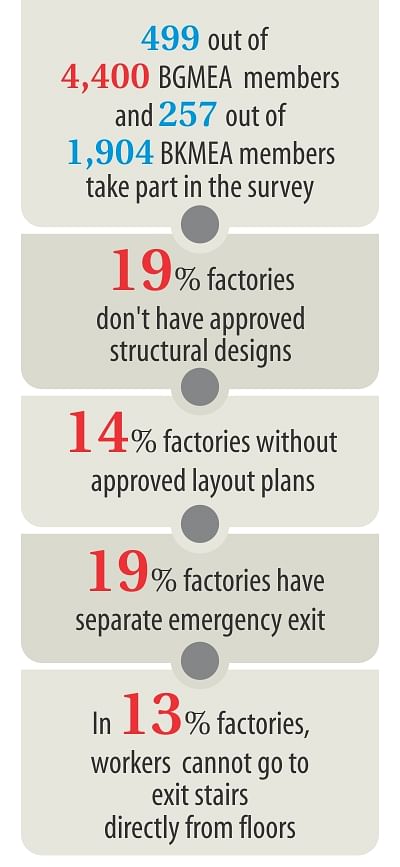Safety in garment factories not as bad as thought

A significant proportion of garment factories abide by workplace safety standards but there are still some critical safety concerns that need urgent attention, a recent survey found.
Following the recent spate of accidents in the sector, the ministry of labour and employment commissioned the Bangladesh Institute of Development Studies to conduct a comprehensive assessment of the current state of the garment sector with respect to industrial relations, workplace safety and compliance.
The study found that about 80.8 percent of the buildings had approved structural designs and 85.9 percent approved factory layouts.
It has been found that 92 percent of the factories have updated fire safety licences. Almost all the factories do have valid fire extinguishers and maintain records of fire-fighting demonstration.
Around 93 percent and 99 percent of the factories respectively had the necessary number of hose reels for fire fighting and alarm system for fire or other disasters. Additionally, 87.9 percent of the factories had water reservoir in the roof to fight fire.
Faulty electric lines often cause fire. Moreover, location of electric generator, main switch board, cut-out systems and so on are also important for avoiding fire from electric lines and generators.
It has been observed that electric generator is located outside of the factory in case of 55 percent of the factories.
However, only about 19 percent of factories have a separate emergency exit, while others maintain that they have more than one stairs and some of these build-in stairs perform as emergency exit.
But, this may not be a tenable position because in case of fire in lower floors of the building, it will be difficult for workers to come out if there is no separate emergency stair. Not having a separate emergency exit thus remains a cause of concern.
Also, 81 percent of the respondent factories had warehouses located inside the building, mostly in the ground floor or first floor, which is risky for workplace safety.
Moreover, although it is mandatory for factories not to have any electric connection inside the warehouse to avert fire initiation, 33 percent of the factories still had it.
About 40 percent of factories had electric substation inside the factory, which is also risky for fire outbreak.
The survey methodology involved sending a two-page questionnaire to the 6,304 member factories of the Bangladesh Garment Manufacturers and Exporters Association and Bangladesh Knitwear Manufac-turers and Exporters Association between the first week of June 2013 and end of July 2013.
Despite repeated reminders from the BGMEA and BKMEA authorities, response to the census was low: only 499 out of 4,400 BGMEA members and 257 of 1,904 BKMEA members responded.
Based on the information collected through the mailed questionnaire, a representative sample of 100 factories was drawn following stratified random sampling procedure for detailed survey.
Because of time and resource constraint, the sample survey was limited to the Dhaka, Gazipur and Narayanganj districts that account for 80 percent of the BGMEA member factories and nearly 94 percent of the BKMEA member factories.
Structured questionnaires were sent to the management of the sample factories and to five randomly selected workers of each sample factory to get their perception on the pertinent issues.
Additionally, one focus group discussion with managers and workers was done separately to understand their knowledge gap towards compliance issues.
The research organisation handed in the detailed report to the labour ministry last week, and the ministry is due to sit with the platforms of international retailers -- Alliance for Bangladesh Worker Safety and Accord on
Fire and Building Safety in Bangladesh -- to discuss the findings, according to an official from the labour ministry.

 For all latest news, follow The Daily Star's Google News channel.
For all latest news, follow The Daily Star's Google News channel. 



Comments